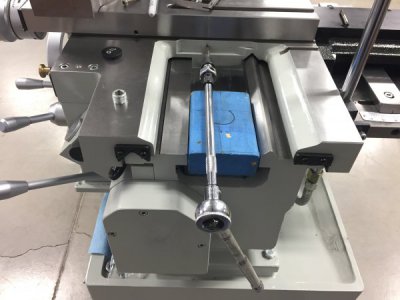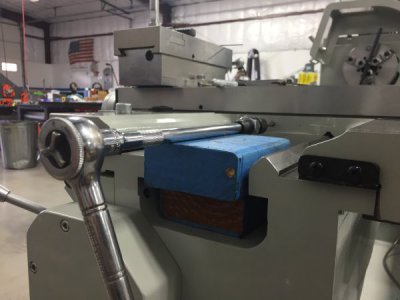I am planning to install a set of DRO on my lathe and milling machine. In doing so I will need to make some mounting screw holes on the machine body by hand tools. May I know if there are good ways to ensure that the holes will be perpendicular to the mounting surface ?
-
Welcome back Guest! Did you know you can mentor other members here at H-M? If not, please check out our Relaunch of Hobby Machinist Mentoring Program!
You are using an out of date browser. It may not display this or other websites correctly.
You should upgrade or use an alternative browser.
You should upgrade or use an alternative browser.
Drilling and tapping on machine body - how to ensure perpendicularity
- Thread starter compact8
- Start date
B
British Steel
Forum Guest
Register Today
I would use a tapping block: mine is about 2" x 3" and three-quarters of an inch thick, with tapping and clearance holes (accurately drilled on the pillar drill) for the thread sizes I use (M3,4,5,6,8 - I'm rest if the world), clamp it if you can or just firmly hold it in place, drill through tapping-drill holes, guide the tap through the clearance holes- Robert is one's parent's sibling.
If you're posh, you can case-harden it (or use a hardenable steel) for durability.
Dave H. (the other one)
If you're posh, you can case-harden it (or use a hardenable steel) for durability.
Dave H. (the other one)
- Joined
- Jul 14, 2017
- Messages
- 2,445
In my opinion there's two ways, first courage focus and do it , second is use fixtures and double check everything couple times before you start and keep checking when doing it. I personally use the first more and can achieve best resorts with it, just focus get comfortable and do it right.
- Joined
- Feb 1, 2015
- Messages
- 9,575
I check by eye or use a tapping block. If you see the tap is not going in straight, be very careful trying to straighten it. It is a sure fire way to break a tap. Use a taper tap. It is easiest to get it to run true and it takes less force to tap, lessening the chances of breakage. Drilling and tapping cast iron, you may run into hard spots; be extra cautious drilling and tapping.
Finally, many cast surfaces are tapered due to draft in the mold patterns necessary to remove the pattern. I have used tapered spacers to correct this and square everything up properly. In the case that the casting surface is irregular, I have made a spacer and drilled and tapped mounting holes. I then put some epoxy on the back side of the spacer and secure it to the casting with screws. This makes for a secure and stress free bedding of the adapter and gives you a true surface to mount your whatever to. In critical cases, I have made a fixture to position the adapter correctly while the epoxy set up.
Finally, many cast surfaces are tapered due to draft in the mold patterns necessary to remove the pattern. I have used tapered spacers to correct this and square everything up properly. In the case that the casting surface is irregular, I have made a spacer and drilled and tapped mounting holes. I then put some epoxy on the back side of the spacer and secure it to the casting with screws. This makes for a secure and stress free bedding of the adapter and gives you a true surface to mount your whatever to. In critical cases, I have made a fixture to position the adapter correctly while the epoxy set up.
F
Firestopper
Forum Guest
Register Today
Personally, I eyeball drilling/tapping when installing DRO. For those long reach areas 2x4 blocks and extensions work well but take your time.
Honestly, I don't like the feeling but I don't trust anyone else to do it, use shop air to clear out the drill and tapping process.
Out of 25+ holes, I only broke one tap and got lucky on that front as it broke with enough sticking out to use tiny needle nose vice grips.


Get er done, you'll love your DRO!
Paco
Honestly, I don't like the feeling but I don't trust anyone else to do it, use shop air to clear out the drill and tapping process.
Out of 25+ holes, I only broke one tap and got lucky on that front as it broke with enough sticking out to use tiny needle nose vice grips.


Get er done, you'll love your DRO!
Paco
- Joined
- Oct 13, 2014
- Messages
- 6,559
Here is how I did my install: https://www.hobby-machinist.com/threads/dro-install-on-mill-updated.46586/
Hope it helps.
Hope it helps.
- Joined
- Feb 13, 2017
- Messages
- 2,138
There is a "tool" for casual / homeowner drilling that makes a hand drill into a sort-of drill press. A fixture that has a flat plate(round) with two bars perpendicular. And a fixture that attaches to the front of the drill and runs on the two bars. The base plate is around 4" diameter, but can be cut down somewhat and de-burred if needed. It is adjusted to a true 90 degrees before drilling, up to (I think) 45 degrees. But I wouldn't try tapping such an angle. It's OK for drilling wood, or even metal, But tapping should be at or near 90 degrees.
The hole(s) are drilled with this device. Then the tap is chucked up and the drill chuck is turned by hand (or with a bar as needed) until 2 or 3 pitches are cut. If a small size is used in thin metal, such as 10-24 and 11 Ga sheet, they might be threaded with power. For heavier metal, turning the tap by hand is less likely to break a tap. In any case, once the tap has a pitch or two to keep things straight, it can be tapped with a hand tap wrench.
I have had the "tool" for so long, I can't remember the name. It came from Sears when the name Craftsman meant something. And the base plate is aluminium, cut up to fit with a hackbaw and deburred. It was originally bought for wood working, running wires in a very old house. I see no reason it could not be used to keep a drill and tap concentric. It's strong enough to feel any mis-alignment. I've used the technique for electrical panels (11 Ga .118") but personally have never tried anything of any size.
The hole(s) are drilled with this device. Then the tap is chucked up and the drill chuck is turned by hand (or with a bar as needed) until 2 or 3 pitches are cut. If a small size is used in thin metal, such as 10-24 and 11 Ga sheet, they might be threaded with power. For heavier metal, turning the tap by hand is less likely to break a tap. In any case, once the tap has a pitch or two to keep things straight, it can be tapped with a hand tap wrench.
I have had the "tool" for so long, I can't remember the name. It came from Sears when the name Craftsman meant something. And the base plate is aluminium, cut up to fit with a hackbaw and deburred. It was originally bought for wood working, running wires in a very old house. I see no reason it could not be used to keep a drill and tap concentric. It's strong enough to feel any mis-alignment. I've used the technique for electrical panels (11 Ga .118") but personally have never tried anything of any size.
Bill Hudson

